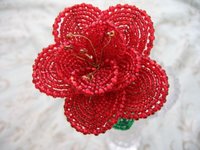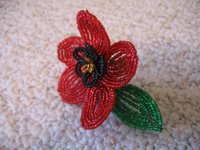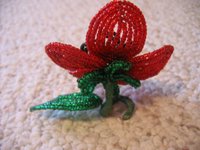
First, I would to apologize for not updating for so long. If anyone is still reading, thank you.
So, here we have two new pears. They were an experiment to see if I could make self-supporting 3D French beaded objects. As it turns out, it is possible, since both of the above examples are completely hollow and do not have any solid form beneath the beads, unlike the first pear I made.
The process to make them is the same as the first one; I used a light air-drying compound similar to Crayola Model Magic to make the pear shape. The pear on the right is made by beading around the shape using the basic frame (24 gauge wire; 2-bead basic). The one on the right is made crossing 2 24-gauge wires (to make a cross frame) and then beading around the frame using 26-gauge wire. After the pear is beaded, the hardest part of the process is removing the form from inside. I did this by sticking needle-nosed pliers into the small opening I left at the top and pulling out bits and pieces of the modeling compound. This was very time consuming, but I eventually finished, and there they are!
The two pears were made differently because I was worried about their stability after I removed the support. As it turns out, the pear on the right is rather flimsy. Even though I laced the sides that were seamless, it is still rather fragile. It holds its shape, but it can still get deformed fairly easily under stress (i.e., if one picks it up and plays with it).
The pear on the right is much more stable. Even though the wire with the beads is 26-gauge, because it was built on a 4-spoke frame, it can hold its shape under mild stress. Even so, it's not quite as stable as I would have liked.
I am working on another pear right now which is made from a quadruple basic frame using 24-gauge wire. So far, it seems to be the most stable!
 This is the cover of a Japanese beading book. At the beginning, there is a gallery of colored pictures of flowers and bouquets. The interesting thing about this book, though, is that it includes a few pictures of non-flower things which are made using French beading. To give you an idea of what is possible, I've included those pictures which illustrate this. The pictures have very high resolution (so you can really see the details) and therefore will take some time to download. The patterns in the book are black and white and are for rather basic flowers and do not contain any instructions for most of the flowers showcased.
This is the cover of a Japanese beading book. At the beginning, there is a gallery of colored pictures of flowers and bouquets. The interesting thing about this book, though, is that it includes a few pictures of non-flower things which are made using French beading. To give you an idea of what is possible, I've included those pictures which illustrate this. The pictures have very high resolution (so you can really see the details) and therefore will take some time to download. The patterns in the book are black and white and are for rather basic flowers and do not contain any instructions for most of the flowers showcased.



































